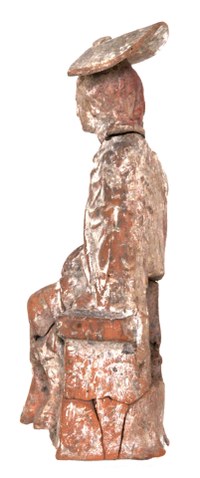Boy (Ephebe?) with sun hat
|
Boy (Ephebe?) with sun hat, Inv. T I-16 Hollow. Front from the mould, back not finished, smoothed, with large almost square kilning hole. Round sculptured head. Hat attached. Provenance: Acquired by Bruno Sauer from the Margaritis Collection. State of preservation: Composed of numerous fragments. Partially sintered. Front half of the hat lost[1]. Nose bumped. Dimensions: H: 14,2 cm; W: 6,2 cm; D: 5,2 cm. References: E. Neuffer, Griechische Terrakotten, Heimat im Bild 17, 1930, 67 f. fig. 5; M. Recke (Hrsg.), Antike Kunst aus der Sammlung der Justus-Liebig-Universität (Gießen 2010) 23. 27 fig. 49. |
Description: A boy is sitting on a rectangular chest, leaning on the protruding lid with his left hand and his right hand in his lap. He wears a curved travelling hat, the petasos, on his head, as well as a cloak with many folds, knotted on the right shoulder, which envelops the body including the left arm and reaches above the knees. Only the right arm is uncovered. On the right shoulder, obscured by partially flaking engobe, a short chiton sleeve is indicated. Close parallels[2] confirm this detail. An oblique fold spans between the shoulder and the left hand, joining vertical and horizontal folds to form an approximately isosceles triangle. Curved folds run across the left arm.
The boy assumes a roughly frontal sitting posture in the centre of the chest. The legs point slightly to the right side, the feet, in high boots, do not touch the ground.
The roundish head is slightly lowered and turned to the right. Short strands of hair frame the high forehead and temples down to the smooth cheeks. Eyes, nose and mouth are close together.
The mouth is closed, the chin appears pointed. Carefully formed lids frame the eyes.
Commentary: The body shape, head and face are those of a youthful adult rather than a boy[3], but the dangling legs give the figure something childlike. Presumably a boy on the threshold of adolescence is meant. The drapery of the Chlamys resembles, especially in the way the fabric billows behind the right upper arm, the drapery of the coat of a type of standing young man in the habitus of the "traveller"[4]. In the same way, the short hair is tightly wrapped around the head and the high forehead. In its physiognomic details, T I-16 is reminiscent of the arching Eros of Lysipp[5]. The pyramidal structure, however, already points to the beginning of the 3rd century BC[6]. Like the majority of the parallels mentioned, the Giessen statuette was probably created in Boeotia (Tanagra).
Determination: Early 3rd century BC; probably from Boeotia.
 |
 |
 |
|---|
[1] Auf einem alten Photo noch vollständig, Neuffer ibid. 1930, 67 f. fig. 5.
[2] S. Besques, Figurines et reliefs grecs en terre cuite (Paris 1994) 90 fig. 80; B. Csornay, Ókori Művézet (Budapest 1987) 8 no. 17 pl. 21; R. Higgins, Tanagra and the Figurines (London 1987) 150. 154 fig. 188; C. E. Vafopoulou-Richardson, Greek Terracottas. Ashmolean Museum (Oxford 1981) 38 fig. 38; Winter II 1903, 256, 5; cf. R. Özgan, Die griechischen und römischen Skulpturen aus Tralleis. AMS 15, 1995, 114-125 pl. 32.
[3] "Soldier-ephebe", L. Burn – R. Higgins, Cat. of Greek Terracottas in the British Museum 3 (London 2001) 64-69 nos. 2118-2121. 2130-2135 pls. 21-25.
[4] Cf. Giessen T I-26; Burn – Higgins ibid. 65 no. 2120 pl. 22; R. Wünsche – M. Steinhart, Sammlung James Loeb (Lindenberg im Allgäu 2009) 119 fig. 54.
[5] M. Bieber, The Sculpture of the Hellenistic Age (New York 1961) 38 figs. 87-89; H. Döhl, Der Eros des Lysipp (Diss. Göttingen 1968); P. Moreno, Opere di Lisippo, in: Lisippo. L'Arte e la Fortuna (Monza 1995) 111-129 pls. 119-121.
[6] G. Krahmer, Stilphasen der hellenistischen Plastik, RM 38/39, 1923/24, 154-157.

